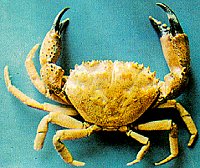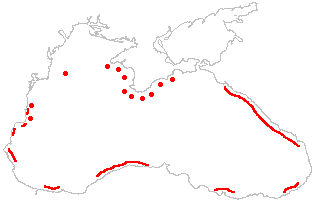 Synonyms:
E. spinifrons Rathke 1837; Czerniavsky 1884, Zernov 1913; E.
verrucosa, Holthuis a. Gottlieb 1958
Synonyms:
E. spinifrons Rathke 1837; Czerniavsky 1884, Zernov 1913; E.
verrucosa, Holthuis a. Gottlieb 1958Eriphia verrucosa Forskall, 1755
 Synonyms:
E. spinifrons Rathke 1837; Czerniavsky 1884, Zernov 1913; E.
verrucosa, Holthuis a. Gottlieb 1958
Synonyms:
E. spinifrons Rathke 1837; Czerniavsky 1884, Zernov 1913; E.
verrucosa, Holthuis a. Gottlieb 1958
Common names: Bulg: Pagurt; Rom: Pagurie; Russ: Kameny krab; Turk: Pavurya; Ukr: Kam'yany krab
Order: DECAPODA
Family: XANTHIDAE
Taxonomic descriptions: Carapace thick, its upper face slightly convex, smooth, and with transverse granulous ridges behind the frontal border and on the lateral regions. Antero- lateral borders shorter than the postero-lateral ones, and armed with 7 tooth-like protrusions, the first ones of which bear secondary lateral spinules, while the last ones are reduced. Front broad, indented in the middle: each frontal lobe is armed with a comb of 5 or 6 teeth; a little behind this is a second, parallel comb consisting of 4 to 5 teeth. Orbits almost circular, their lower border denticulated. Chelipeds strong and unequal; the larger one generally bears rounded tubercles in front of the upper articulation with the carpus; the smaller one bears numerous sharper tubercles arranged in lines. Black fingers; the movable finger with a strong obtuse tooth and some smaller; unmovable finger with subtriangular teeth. The pereiopods with strong hairs, rare, without spines. Female with a large abdomen, oval. Male with narrow abdomen. Large-size species. Length: 6.5-7 cm; width: 8-9 cm; colour: brownish-red or brownish-green, with yellow spots.
 IUCN
Status:
IUCN
Status:
World level:
Black Sea Regional level:
Subregion level: EN
Distribution:
Habitats type, Critical habitats, Limiting factors: Shallow waters along rocky coasts living among stones and seaweeds, to 5-15 m depths. Favorite biotop: stony grounds. Present throughout the Mediterranean Sea, also in the eastern Atlantic from the southern coast of Brittany to Mauritania and the Azores. Terrigenous pollution, hard frost, hypoxia.
Biology: Species with a high prolificity Reproduction begins in May - June. In spring it makes migrations in the shallow waters under 1 m in depth. Planktonic larvae with 4 metamorphosis stages from zoe to megalope. Eats molluscs, polychaetes.
Population trends: Frequent in the past it became very rare after the 1980s; at present no specimens can be found.
Threats: Eutrophication (hypoxia caused by phytoplankton blooms), pollution.
Conservation measures taken: Included in the Ukrainian Red Data Book, 1994.
Conservation measures proposed: To prohibit catching by people for food consumption.
References:
Compiled by: C.Dumitrache., T.Konsulova